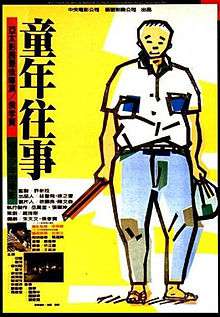The Time to Live and the Time to Die
| A Time to Live, A Time to Die | |
|---|---|
 | |
| Chinese | 童年往事 |
| Mandarin | Tóngnián wǎngshì |
| Literally | Childhood events |
| Directed by | Hou Hsiao-Hsien |
| Written by |
Chu Tien-wen Hou Hsiao-Hsien |
| Starring |
You An-shun Tien Feng Xin Shufen |
| Music by | Wu Chu-chu |
| Cinematography | Mark Lee Ping-Bin |
| Distributed by | Central Motion Pictures Corporation |
Release dates | 1985 |
Running time | 138 minutes |
| Country | Taiwan |
| Language | Mandarin/Hakka Chinese/Taiwanese |
The Time to Live and the Time to Die, also known as A Time to Live, A Time to Die is a 1985 film directed by Hou Hsiao-Hsien. This film is inspired by screenwriter-turned-director Hou's own coming-of-age story.
This film is the second part of Hou's coming-of-age trilogy, preceded by A Summer at Grandpa's (1984) and followed by Dust in the Wind (1986).
Plot
Spanning the years 1947–65, the film follows the maturation of Ah-ha (Ah-hsiao) as he and his family (parents, grandmother, older sister, three brothers) cope with the shock of leaving their homeland (the grandmother keeps talking about returning to the mainland to visit the ancestors). Having been only a child during the move, Ah-ha quickly acclimatizes himself to the new country, often putting him at odds with his more traditional family; he joins a street gang and has to choose between that life and taking the college entrance exam.
Cast
- Chia-bao Chang
- Neng Chang
- Chih-chen Chen
- Han-wen Chen
- Shu-fang Chen
- Bao-te Chiang
- Tung-hung Chou
- Ai Hsiao
- Hsiang-ping Hu
- Tung-lai Kao
- Chung-wen Lin
- Kuo-bao Liu
- Cheng-ye Lo
- Shun-lin Lo
- Tse-chung Lo
Awards
- 1986 Berlin International Film Festival Forum of New Cinema
- Won: FIPRESCI Prize
- 1987 Rotterdam International Film Festival
- Won: Rotterdam Award – Best Non-American/Non-European Film
- 1990 Kinema Junpo Awards
- Won: Best Foreign Language Film Director – Hou Hsiao-hsien
Reception
Review aggregator Rotten Tomatoes reports 100% approval for The Time to Live and the Time to Die, based on five reviews with an average rating of 8.2/10. Janet Maslin of the New York Times praised its cinematography and wrote that "much of the film is about suffering and loss, detailing the painful circumstances in which family members, one by one, grow ill and die. The simplicity and tact with which these illnesses are chronicled help to give an otherwise largely uneventful film some emotional impact…It's an unpretentious and largely unremarkable film that occasionally reaches unexpected depths of feeling."[1] Variety called it a "beautifully controlled and highly nostalgic picture of childhood."[2]
Legacy
Derek Malcolm has compared Hou Hsiao-hsien to Satyajit Ray and wrote that the film's honesty and truth "manage[s] to summon up this little microcosm of the world perfectly…Everything is right: the miraculous use of sound, the limpid cinematography, the natural acting create an atmosphere you can't forget."[3] Jonathan Rosenbaum praised its long takes and deep focus cinematography and called it "unhurried family chronicle carries an emotional force and a historical significance that may not be immediately apparent."[4] Geoff Andrew of Time Out wrote that "It is the unflinching, unsentimental honesty that supplies the elegiac intelligence: Hou's quiet style bursts forth, here and there, into sudden, superlative scenes of untrammelled emotional power. It's a brilliantly simple but multi-faceted portrait of loss and the complacency of childhood: quite literally, we can't go home again."[5]
References
- ↑ Maslin, Janet (September 23, 1986). "A Time to Live and a Time to Die (1985) 'TIME TO LIVE' RECOUNTS STORY OF TAIWAN FAMILY". New York Times. Retrieved February 23, 2015.
- ↑ "Review: 'Tongnian Wangshi'". Variety. December 31, 1984. Retrieved February 23, 2015.
- ↑ Malcolm, Derek. "Hou Hsiao-hsien: The Time to Live and the Time to Die". The Guardian. Retrieved February 23, 2015.
- ↑ Rosenbaum, Jonathan (2013). "A Time to Live and a Time to Die". Chicago Reader. Retrieved February 23, 2015.
- ↑ Andrew, Geoff. "The Time to Live and the Time to Die". Time Out London. Retrieved February 23, 2015.